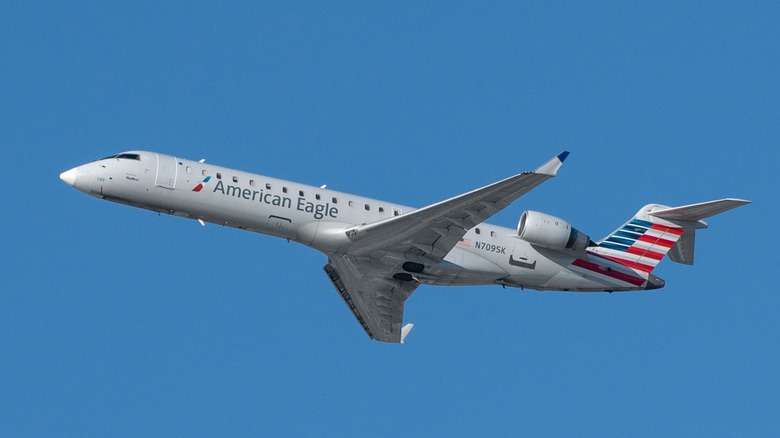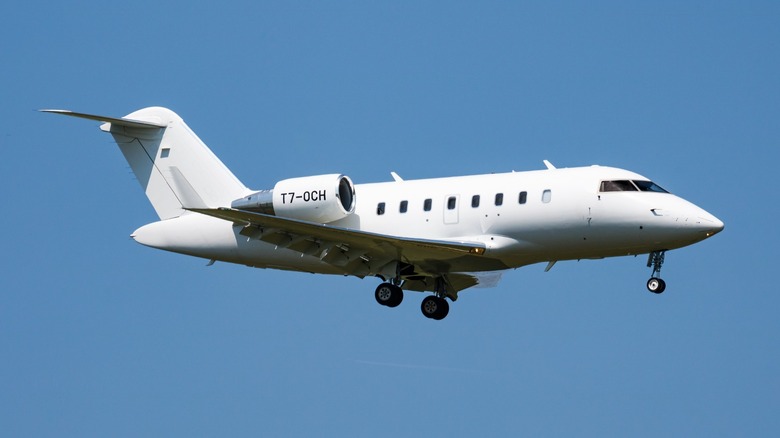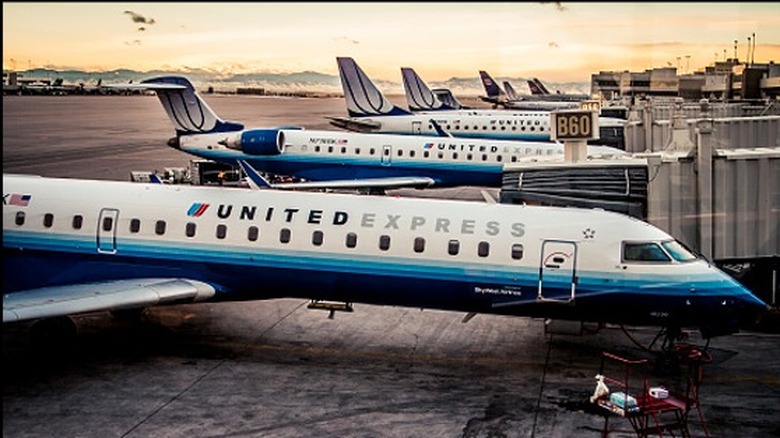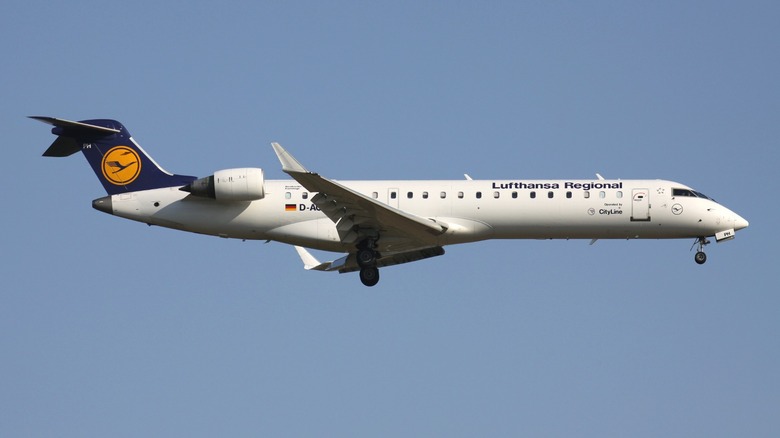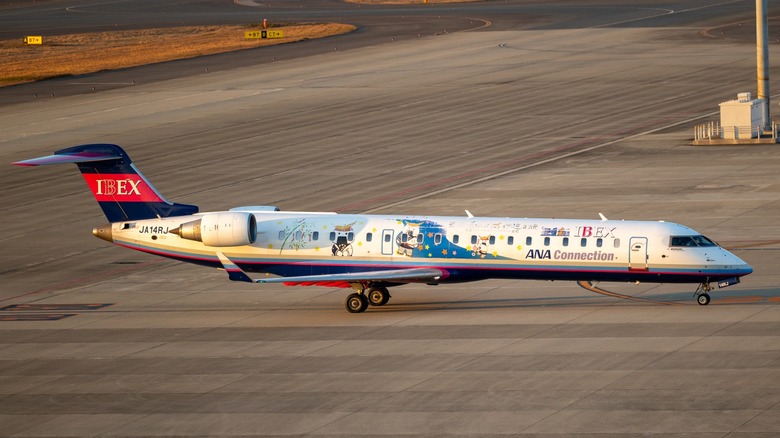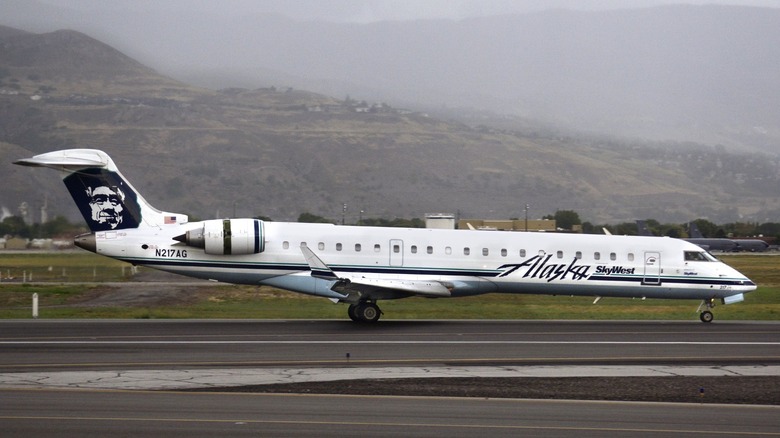Everything To Know About The Canadair Regional Jet 700 (CRJ700)
The CRJ700 is one of the most popular regional airliners in the world, with over 800 examples of the three models flying across five continents. If you've flown aboard SkyWest, PSA, or Endeavor, you've probably done so in a CRJ700 family aircraft.
Unlike most popular airliners like the 737 and the A320, the CRJ700 isn't made by Boeing or Airbus. Instead, it was the brainchild of Canada-based aerospace company Canadair. It manufactured license-built variants of several aircraft like the Canadair Sabre (based on the North American Aviation F-86 Sabre) and the Canadair CF-104 Starfighter (based on the Lockheed F-104 Starfighter).
Canadair was developing the Challenger business jet when Bombardier, another Canadian aviation firm, bought it. Bombardier continued the Challenger, making it one of the most popular business jets today and turning Bombardier into one of the best private jet manufacturers globally. The Challenger then grew in size and weight, eventually becoming the regional airliner we know today.
Business jet turned airliner
The Challenger 600 began life as a business jet in 1980 and has an impressive cabin width of over eight feet. This meant it wouldn't take much to stretch it into an airliner, which Bombardier did with the CRJ100, which made its first flight in 1991. The CRJ100/200 series proved a popular aircraft, with 481 airframes still flying with 46 airlines globally.
As many customers demanded a bigger jet, Bombardier developed the 50-seat CRJ100/200 into the CRJ700. This aircraft could seat 66 to 78 passengers, but its larger variants could seat up to 104, effectively doubling the smaller jet's capacity. The CRJ700 also increased the 980-nautical mile range of the base CRJ100 to 1,430 nautical miles, allowing it to fly farther distances and reach more airports.
The CRJ700 is powered by two GE CF-43 turbofans, giving it a 442-knot cruise speed. This made it much faster than its turboprop competitors with a similar capacity, like the ATR 72-600. It also had a more extended range, too.
The CRJ700-series family
The CRJ700 spawned three variants: The original 700 with the 1,430-nautical mile range, the Extended Range version (which increased the range to 1,730 nautical miles), and the Long Range version, which has a 2,185-nautical mile range.
Aside from these variants, Bombardier also produced stretched versions of the 700. These include the CRJ900, which seats 81 to 90 passengers, and the CRJ1000, which has a capacity of 97 to 104 people. Bombardier also made the CRJ550 for United, essentially a CRJ700 with only 50 seats, allowing operators to give the aircraft a 3-class configuration.
The CRJ900 also has three variants: The standard 900 with a 1,590-nautical mile range, the CRJ900ER extended range that can fly up to 1,593 nautical miles, and the CRJ900LR long-range variant, which can hit up to 1,835 nautical miles. On the other hand, the CRJ1000 only comes in two flavors: the standard 1000 with a 1,490-nautical mile range and the CRJ1000ER, which can fly up to 1,690 nautical miles.
CRJ family operators
Brit Air, a French regional airline now part of Air France Hop, was the CRJ700's launch customer in 2001. As of 2019, other notable carriers with the CRJ700 in their fleet include SkyWest, which has 101 examples; PSA Airlines, with 49; and GoJet Airlines, with 45.
The CRJ900 is also quite popular, with SkyWest operating 42, PSA Airlines flying 59, and Endeavor Air with 109. This aircraft type is also popular outside North America, with European airlines, like SAS, owning 26 in their fleet and Lufthansa CityLine having 35. China Express Airlines from mainland China has 38 CRJ900s in its fleet, while Indonesian airline Garuda Indonesia has 18 CRJ1000s, making the CRJ a genuinely global fleet.
Aside from airlines, many other private and government institutions operate CRJ700 family aircraft. This list includes China's People's Liberation Army Air Force and Naval Air Force, Banco de Mexico, the Turkmenistan government, and several private jet charter companies.
From Canada to Japan
Although Bombardier's CRJ-series aircraft was a massive success, it saw the need for an even larger airliner in the 100- to 150-seat range. This led to the C-Series program, which the company launched in 2008 at the Farnborough International Airshow.
The C-Series gained considerable interest, with Air Baltic and Swiss International Air Lines becoming one of the first customers to order the aircraft. However, Boeing complained to the U.S. government when Delta ordered the aircraft from Bombardier, which led to the plane gaining a 300% tax duty if Delta wanted to buy it.
Although this decision was later overturned, the damage has already been done to Bombardier, which had been struggling for years due to the C-Series' development costs, among other issues. This led to the company selling many of its divisions, with the C-Series going to Airbus and becoming the Airbus A220, Longview Aviation acquiring the Dash 8 Q400 program, and, finally, the CRJ line being acquired by Mitsubishi Heavy Industries (MHI).
End of Production
Although Mitsubishi bought the CRJ line in 2020, Bombardier was already on the way to wrapping up its production before that, especially as the CRJ design was almost 30 years old by then. Nevertheless, Bombardier will continue building components and spare parts for the CRJ line for MHI.
Mitsubishi bought the CRJ line to help develop and sell its own homegrown aircraft, the Mitsubishi Regional Jet, which was eventually renamed the Mitsubishi SpaceJet. Unfortunately, the company eventually canceled this program, stating that the program had "failed to confirm sufficient business viability."
With this turn of events, the CRJ program is truly no more, with the last new airframe delivered to SkyWest in 2021. However, we still expect to see CRJ700s and its other family members in the skies for decades, especially as services continue for these planes. Hopefully, it will make our list of the oldest aircraft still in service today in the future. After all, as long as an airplane is properly maintained, it could fly for many years after the end of its production run.
